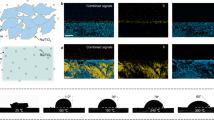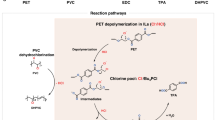Abstract
The accumulation of plastic waste in the environment has led to a global crisis with severe consequences for wildlife and ecosystems. Upcycling offers a promising solution for reducing plastic waste by converting it into valuable chemicals and fuels. Real-life plastic waste exists as complex mixtures of different types of plastic, which poses a key challenge for efficient upcycling. Here, by using sunlight as the sole energy source, we report a thermocatalytic approach for transforming a plastic waste mixture collected from daily usage into methane and HCl using an earth-abundant Ni-based catalyst. This process successfully converted 1.03 g of a plastic waste mixture, containing five types of polyolefin, polyester and polyvinyl chloride, into 1.08 g of methane (yieldC 98%) and 0.045 g of HCl (yieldCl 91%). Catalyst deactivation caused by chlorine poisoning is prevented through the temperature-ramped process driven by the diurnal sunlight cycle, ensuring sustained catalytic activity over a period of 10 days.

This is a preview of subscription content, access via your institution
Access options
Subscribe to this journal
Receive 12 digital issues and online access to articles
$119.00 per year
only $9.92 per issue
Buy this article
- Purchase on Springer Link
- Instant access to full article PDF
Prices may be subject to local taxes which are calculated during checkout




Similar content being viewed by others
Data availability
Source data are provided with this paper.
References
Stubbins, A., Law, K. L., Muñoz, S. E., Bianchi, T. S. & Zhu, L. Plastics in the Earth system. Science 373, 51–55 (2021).
Santos, R. G., Machovsky-Capuska, G. E. & Andrades, R. Plastic ingestion as an evolutionary trap: toward a holistic understanding. Science 373, 56–60 (2021).
MacLeod, M., Arp, H. P. H., Tekman, M. B. & Jahnke, A. The global threat from plastic pollution. Science 373, 61–65 (2021).
Korley, L. T. J., Epps, T. H., Helms, B. A. & Ryan, A. J. Toward polymer upcycling—adding value and tackling circularity. Science 373, 66–69 (2021).
Geyer, R. in Plastic Waste and Recycling (ed. Letcher, T. M.) Ch. 2, 13–32 (Academic Press, 2020).
Jehanno, C. et al. Critical advances and future opportunities in upcycling commodity polymers. Nature 603, 803–814 (2022).
Zhang, F. et al. Polyethylene upcycling to long-chain alkylaromatics by tandem hydrogenolysis/aromatization. Science 370, 437–441 (2020).
Conk, R. J. et al. Catalytic deconstruction of waste polyethylene with ethylene to form propylene. Science 377, 1561–1566 (2022).
Sullivan, K. P. et al. Mixed plastics waste valorization through tandem chemical oxidation and biological funneling. Science 378, 207–211 (2022).
Zhang, W. et al. Low-temperature upcycling of polyolefins into liquid alkanes via tandem cracking-alkylation. Science 379, 807–811 (2023).
Wu, X. et al. Size-controlled nanoparticles embedded in a mesoporous architecture leading to efficient and selective hydrogenolysis of polyolefins. J. Am. Chem. Soc. 144, 5323–5334 (2022).
Tamura, M. et al. Structure-activity relationship in hydrogenolysis of polyolefins over Ru/support catalysts. Appl. Catal. B 318, 121870 (2022).
Zichittella, G. et al. Hydrogenolysis of polyethylene and polypropylene into propane over cobalt-based catalysts. JACS Au 2, 2259–2268 (2022).
Liu, S., Kots, P. A., Vance, B. C., Danielson, A. & Vlachos, D. G. Plastic waste to fuels by hydrocracking at mild conditions. Sci. Adv. 7, eabf8283 (2021).
Jia, C. et al. Deconstruction of high-density polyethylene into liquid hydrocarbon fuels and lubricants by hydrogenolysis over Ru catalyst. Chem. Catal. 1, 437–455 (2021).
Sun, M. et al. Efficient upgrading of polyolefin plastics into C5–C12 gasoline alkanes over a Pt/W/Beta catalyst. Sustain. Energy Fuels 6, 271–275 (2022).
Lee, W.-T. et al. Catalytic hydrocracking of synthetic polymers into grid-compatible gas streams. Cell Rep. Phys. Sci. 2, 100332 (2021).
Vance, B. C., Kots, P. A., Wang, C., Granite, J. E. & Vlachos, D. G. Ni/SiO2 catalysts for polyolefin deconstruction via the divergent hydrogenolysis mechanism. Appl. Catal. B 322, 122138 (2023).
Wang, N. M. et al. Chemical recycling of polyethylene by tandem catalytic conversion to propylene. J. Am. Chem. Soc. 144, 18526–18531 (2022).
Walker, T. W. et al. Recycling of multilayer plastic packaging materials by solvent-targeted recovery and precipitation. Sci. Adv. 6, eaba7599 (2020).
Jehanno, C. et al. Selective chemical upcycling of mixed plastics guided by a thermally stable organocatalyst. Angew. Chem. Int. Ed. 60, 6710–6717 (2021).
Paucar-Sánchez, M. F. et al. Thermal and catalytic pyrolysis of a real mixture of post-consumer plastic waste: an analysis of the gasoline-range product. Process Saf. Environ. Prot. 168, 1201–1211 (2022).
Martínez-Narro, G., Prasertcharoensuk, P., Diaz-Silvarrey, L. S., Dixon, L. & Phan, A. N. Chemical recycling of mixed plastic waste via catalytic pyrolysis. J. Environ. Chem. Eng. 10, 108494 (2022).
Yu, J., Sun, L., Ma, C., Qiao, Y. & Yao, H. Thermal degradation of PVC: a review. Waste Manag. 48, 300–314 (2016).
Ye, L., Li, T. & Hong, L. Co-pyrolysis of Fe3O4-poly(vinyl chloride) (PVC) mixtures: mitigation of chlorine emissions during PVC recycling. Waste Manag. 126, 832–842 (2021).
Fagnani, D. E., Kim, D., Camarero, S. I., Alfaro, J. F. & McNeil, A. J. Using waste poly(vinyl chloride) to synthesize chloroarenes by plasticizer-mediated electro(de)chlorination. Nat. Chem. 15, 222–229 (2022).
Argyle, M. & Bartholomew, C. Heterogeneous catalyst deactivation and regeneration: a review. Catalysts 5, 145–269 (2015).
Gracia, F. J., Miller, J. T., Kropf, A. J. & Wolf, E. E. Kinetics, FTIR, and controlled atmosphere EXAFS study of the effect of chlorine on Pt-supported catalysts during oxidation reactions. J. Catal. 209, 341–354 (2002).
Gravil, P. A. & Toulhoat, H. Hydrogen, sulphur and chlorine coadsorption on Pd(111): a theoretical study of poisoning and promotion. Surf. Sci. 430, 176–191 (1999).
Chu, S. et al. Photocatalytic conversion of plastic waste: from photodegradation to photosynthesis. Adv. Energy Mater. 12, 2200435 (2022).
Xu, J. et al. Plastics-to-syngas photocatalysed by Co–Ga2O3 nanosheets. Natl Sci. Rev. 9, nwac011 (2022).
Bhattacharjee, S. et al. Photoelectrochemical CO2-to-fuel conversion with simultaneous plastic reforming. Nat. Synth. 2, 182–192 (2023).
Kikuchi, E. & Morita, Y. Hydrogenolysis of n-pentane on nickel catalyst. J. Catal. 15, 217–223 (1969).
Leclercq, G., Leclercq, L., Bouleau, L. M., Pietrzyk, S. & Maurel, R. Hydrogenolysis of saturated hydrocarbons IV. Kinetics of the hydrogenolysis of ethane, propane, butane, and isobutane over nickel. J. Catal. 88, 8–17 (1984).
Galvagno, S., Schwank, J., Gubitosa, G. & Tauszik, G. R. Ethane and propane hydrogenolysis on Ru catalysts. J. Chem. Soc. Faraday Trans. 1 78, 2509–2520 (1982).
Bond, G. C. & Yide, X. Hydrogenolysis of alkanes. Part 2.—Hydrogenolysis of n-butane over variously treated Ru/TiO2 catalysts. J. Chem. Soc. Faraday Trans. 1 80, 3103–3118 (1984).
Kempling, J. C. & Anderson, R. B. Hydrogenolysis of n-butane on supported ruthenium. Ind. Eng. Chem. Process Des. Dev. 9, 116–120 (1970).
Dufaud, V. & Basset, J.-M. Catalytic hydrogenolysis at low temperature and pressure of polyethylene and polypropylene to diesels or lower alkanes by a zirconium hydride supported on silica-alumina: a step toward polyolefin degradation by the microscopic reverse of Ziegler–Natta polymerization. Angew. Chem. Int. Ed. 37, 806–810 (1998).
Kots, P. A., Vance, B. C., Quinn, C. M., Wang, C. & Vlachos, D. G. A two-stage strategy for upcycling chlorine-contaminated plastic waste. Nat. Sustain. 6, 1258–1267 (2023).
https://www.liquisearch.com/heat_of_combustion/heat_of_combustion_tables
Acknowledgements
This work received financial support by National Key R&D Program of China (2022YFE0114900 and 2021YFA1501102), National Natural Science Foundation of China (22232001, 21932002, 22072002 and 22378094), China National Petroleum Corporation-Peking University Strategic Cooperation Project of Fundamental Research, and New Cornerstone Science Foundation. We also acknowledge R. Mi, M. Zhang, T. Wang, Z. Guo, Y. Jiao, R. Cao and S. Tian for help with experimental setup and analysis. D.M. acknowledges support from the Tencent Foundation through the XPLORER PRIZE.
Author information
Authors and Affiliations
Contributions
D.M. conceived the project. Y.G., M.W., S. Yuan, J.Y. and S. Yu performed most of the reactions. J.D. and J.Y. did the LCA and TEA analysis. M.W., Y.G., B.X. and D.M. wrote the paper. All authors contributed to the discussion and revision of the paper.
Corresponding author
Ethics declarations
Competing interests
The authors declare no competing interests.
Peer review
Peer review information
Nature Chemical Engineering thanks Huiyan Zhang, Massimiliano Delferro and the other, anonymous, reviewer(s) for their contribution to the peer review of this work.
Additional information
Publisher’s note Springer Nature remains neutral with regard to jurisdictional claims in published maps and institutional affiliations.
Supplementary information
Supplementary Information
Supplementary discussion, Figs. 1–27 and Tables 1–14.
Source data
Source Data Fig. 2
Source data for Fig. 2.
Source Data Fig. 3
Source data for Fig. 3.
Source Data Fig. 4
Source data for Fig. 4.
Rights and permissions
Springer Nature or its licensor (e.g. a society or other partner) holds exclusive rights to this article under a publishing agreement with the author(s) or other rightsholder(s); author self-archiving of the accepted manuscript version of this article is solely governed by the terms of such publishing agreement and applicable law.
About this article
Cite this article
Wang, M., Gao, Y., Yuan, S. et al. Complete hydrogenolysis of mixed plastic wastes. Nat Chem Eng (2024). https://doi.org/10.1038/s44286-024-00064-y
Received:
Accepted:
Published:
DOI: https://doi.org/10.1038/s44286-024-00064-y



